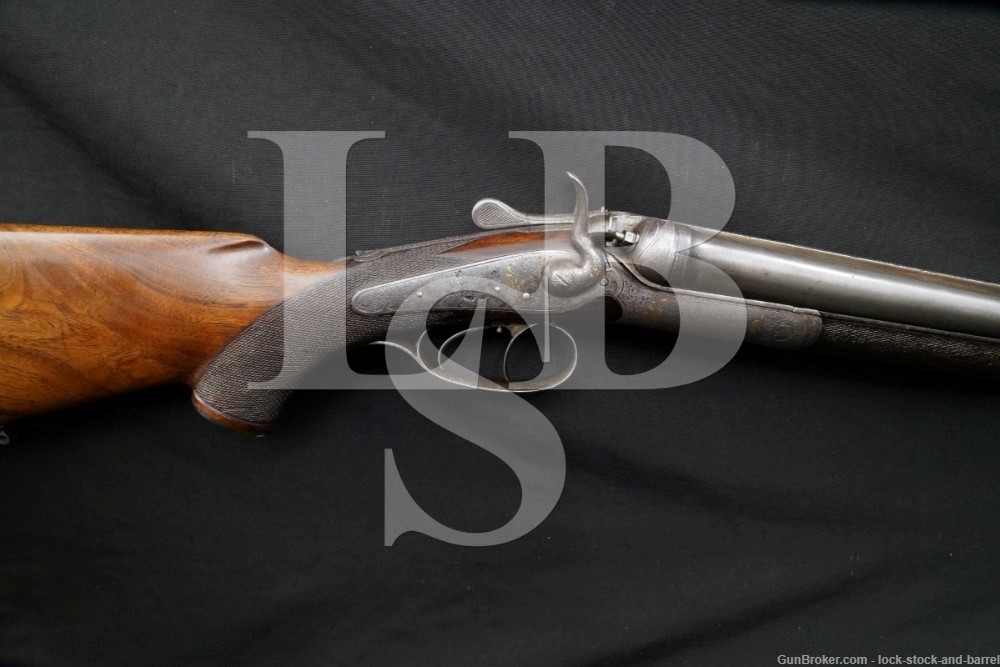
Engraved Austrian 9.3x72R 9.3x72mm Back Action Hammer Double Rifle 1904 C&R
SOLD FOR: $1725
LSB#: 210906MB14
Make: Austrian
Model: Double Rifle
Serial Number: None.
Year of Manufacture: 1904
Caliber: 9.3x72mmR (Rimmed)
Action Type: Back-Action External Hammer Double Rifle with Extractor and Front Single Set-Trigger
Markings: The bottom of each barrel is marked “9.3” and with Austrian proof marks, the bottom of the right barrel is marked “4845.04” (4,845th gun proofed at that proof house in 1904). The bottom of the forend lug is marked “602”, the left “3669”. There are numbers marked on the bottom of the rib, but they are worn and some are not legible. The receiver, hammers, guard and sideplates are fully engraved with game scenes and gold inlay motifs.
Barrel Length: 25 1/2″
Sights / Optics: The front sight is a blade dovetailed to a rise at the front of the barrel’s solid rib. The rear sight is a “V”-notch dovetailed to the rear of the rib. The top of the rib is finely serrated for glare reduction. There is a folding aperture sight mounted to the top tang behind the lever. The folding sight is not properly co-witnessed with the fixed rear sight and cannot be used with the rear sight that is installed.
Weight: 7 lb., 2.4 oz.
Stock Configuration & Condition: The stocks are two-piece checkered walnut with lever-secured splinter forend, capped pistol grip, straight comb with European-style cheekpiece, checkered steel buttplate with trapdoor over storage for four cartridges, and sling stud in the belly (the other stud is mounted to the barrel rib in front of the forend). The stocks have some scattered nicks, scuffs and scratches. There are small losses at the rear edge of the forend’s lever. The buttstock has a filled knot-hole on the right above the belly. There is discoloration around the rear edges of the buttstock where it meets the buttplate. The checkering shows wear, most notable on the forend, but much is well defined. The LOP measures 13 1/4″ and 12″ from the fronts of the triggers to the back of the buttplate. The plate has wear around the edges which shows treatment with cold blue and some stubborn residue in the checkering on the left side, but otherwise has minor wear and sharp checkering. The cast is about neutral. Overall, the stocks are in about Very Good condition.
Type of Finish: Blue & Case Color
Finish Originality: The barrels show treatment with cold blue, the receiver’s finish is original.
Bore Condition: The bores are mostly bright with sharp rifling. There is infrequent minor erosion in the bores.
Overall Condition: This rifle retains about 20% of its metal finish. The barrels have finish wear scattered throughout with strongest finish at the breech and muzzle ends, along the edges of the rib, and in the area covered by the forend. The exposed portions of the receiver are worn to white, though the gold inlay is still strong, and the water table’s case color is visible, but muted. There is scattered surface erosion, lighter on the receiver than the barrels. The screw heads range from sharp to lightly tool marked with strong slots. The markings are generally clear, some of the engraving is slightly obscured by erosion. Overall, this rifle is in Good condition.
Mechanics: The action functions properly. The barrels lock up with no play. The front trigger is a single-set-strigger, pushed forward to set. We have not fired this rifle. As with all previously owned firearms, a thorough cleaning may be necessary to meet your maintenance standards.
Box, Paperwork & Accessories: None.
Our Assessment: Most frequently chambered for potent cartridges and giving the user an extremely fast and reliable follow-up shot, double rifles have long been considered the quintessential gun for safaris and dangerous game. This is a very svelte example of a double rifle, made in Austria in 1904. Chambered for 9.3x72mm Rimmed, the rifle’s small size and light weight belies its power. The rifle does not have any maker’s information, suggesting that it may be a “guild gun”, though the quality of manufacture does make one wonder why the maker didn’t mark it. The only hint is an odd ridge on the bottom of the left barrel, with which the maker may have taken issue. The forend is quite well fit to this ridge and it is scarcely noticed unless the forend is removed. This is a nice example of old-world gunmaking from the late years of the Habsburg Monarchy which will add to any collection. It still has good bores and strong mechanics, so it may also still have more trips in the field left, too. Please see our photos and good luck!

